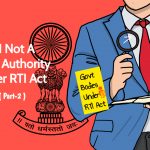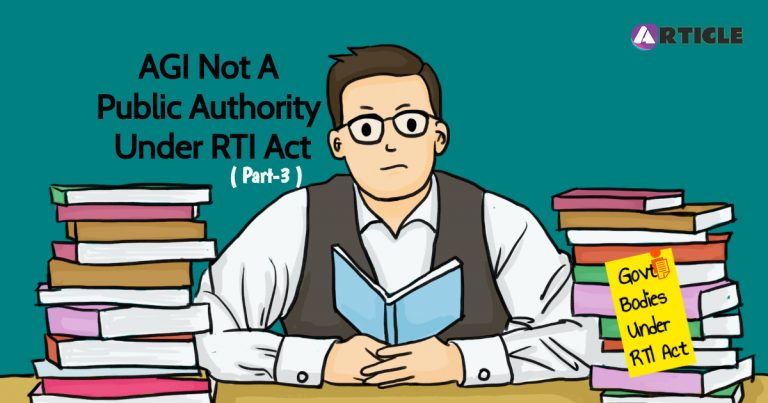In the third and the final part of this series of articles, I continue my analysis and examination of the legal reasoning advanced by the Division Bench of the High Court of Delhi in overturning the decision of the single Bench which had held the Attorney General for India to be a ‘Public Authority’ for the purpose of ‘RTI Act’. Here goes this third and the final part. You can read the first part here and the second part here.
Misplaced Idea of bringing Sec. 126 of the Indian Evidence Act into Picture.
Secondly, I think that the division Bench’s idea of bringing section 126 of the Indian Evidence Act into the picture is indeed a misplaced idea in the first place. The point is what information can be disclosed and what can’t be disclosed is a secondary issue in this matter. The primary issue is to decide whether the office of the AGI is a ‘Public authority’ or not? It is possible that certain information cannot be legally disclosed, but that can never be a ground to refuse to be a ‘Public authority’. Every ‘Public authority’ has the right not to disclose certain legally exempted information but does it mean that they can claim not to be a ‘Public authority’ on this very ground?
Someone may be willing to know the expenditure incurred on AGI’s personal staffs including private secretary, stenographer, and Jamadar, the amount of his telephone bills from the public money, the concession he gets on residential allotments from the exchequer money, the vehicles allowances, etc. These things are not part of the ‘professional communication’ and every citizen has the right to know about its money the government spends.
Also, the argument of section 126 doesn’t hold much ground in the sense that the two provisos to this section carve out two strong exceptions where there is no legal protection from the disclosure. For instance, Exception (1) to section 126 is ‘any such communication made in furtherance of any illegal purpose.’ Further, the kind of professional communications mentioned in illustrations (b) and (c) of section 126 are also not protected from disclosure which means that information relating to any similar situation is not immune from disclosure. Let us take a look at the illustration (b) to section 126 of the Indian Evidence Act. It states:
A, a client, says to B, an attorney – “I wish to obtain possession of the property by the use of a forged deed on which I request you to sue” This communication, being made in furtherance of a criminal purpose, is not protected from disclosure.
Now, suppose a citizen wants to know from the office of the AGI about any such communication made in furtherance of any illegal purpose then this is not protected from disclosure under exception (1) to section 126 of the Indian Evidence Act itself. Similarly, if someone wants to know from the office of the AGI about the kind of information described in illustrations (b) and (c) of section 126 of the Indian Evidence Act, then that too is not protected from disclosure. If this sort of information described above in the exceptions or illustrations is demanded from the office of the AGI, which is not legally protected from disclosure, then by what authority the AGI shall refuse its disclosure, if his office is declared to be a ‘Public authority’?
Sadly, the division Bench didn’t bother to touch this aspect of section 126 of the Indian Evidence Act, which it brought to substantiate its reasoning. Moreover, whether the relationship between the AGI and the GOI, is strictly that of a lawyer-client still needs to be judicially analyzed and established, because unlike other normal lawyer-client relationship, the AGI is constitutionally mandated to advise the GOI and represent it in the Courts. There are lots of restrictions placed on the AGI, for example, not to defend any other accused in the criminal prosecution without the permission of the GOI or accept an appointment to any office in any company without the GOI’s permission, etc. which in other lawyer-client relationship doesn’t exist.
The Superfluous arguments of the fiduciary relationship.
The division Bench left no stone unturned to point out that there exists a fiduciary relationship between the AGI and the Government of India. Here again, the division Bench got deviated from the primary question of whether the AGI is a ‘Public authority’ or not, in order to answer the second question which hardly has any relevance here. There may be a fiduciary relationship but under the ‘Right to Information Act’ that is not a ground to refuse to be a ‘Public authority’.
Section 2(h) of the RTI Act, positively defines that who can be a ‘Public authority’; it doesn’t negatively define that who cannot be a ‘Public authority’ and on what grounds. There is no such concept at all under this transparency legislation. If the office of the AGI is declared to be a ‘Public authority’, it can still withhold information on the ground of fiduciary relationship, as many other ‘Public authorities’ do so rightly, but the fiduciary relationship per se cannot be a ground to refuse to be a ‘Public authority’.
Therefore, in my opinion, the Supreme Court must come forward to save the peoples’ right to information, by setting aside the erroneous decision of the Division bench of the High Court of Delhi.
You will also like :



